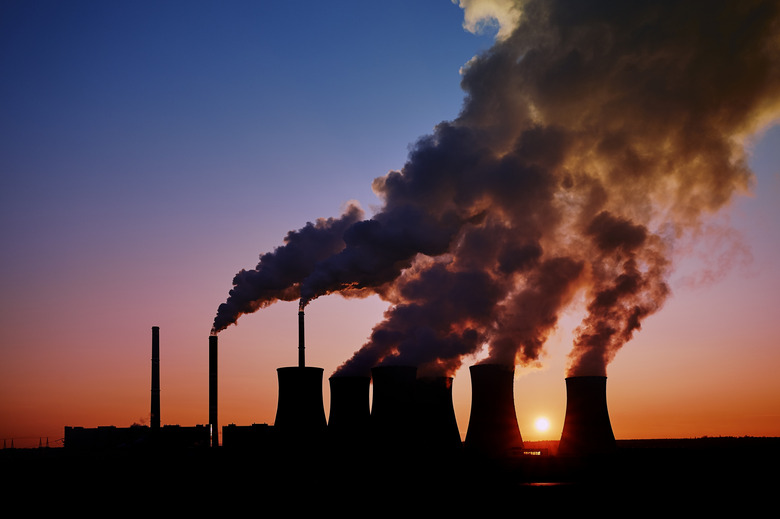Types Of Industrial Pollutants
For nearly 200 years, American consumers have relied on industrial processes to create the products we use every day. From the smallest electronic devices to the largest vehicles, industrial methods of production have revolutionized modern life. Unfortunately, a major side effect of increased industrial production is pollution. Industrial pollution can affect the air we breathe, the water we drink, the ground we walk on and even the light we see and sounds we hear.
Air Pollutants
Air Pollutants
The image of smokestacks belching black, noxious fumes into the air often comes to mind when people think of industry. While visible air pollutants are dangerous, industrial processes also create invisible gasses that can pollute our air supply. Carbon monoxide is a colorless, odorless, tasteless gas used in the production of polyurethane and other plastics. Even "light" industry can emit toxic gasses; dry-cleaning plants, for example, use perchlorethlyene, a chemical linked to liver damage, skin irritation and respiratory failure. Perchloroethylene can leak into the atmosphere when dry-cleaner workers transfer clothes from the washer to the dryer and when the dryer exhaust is vented into the air outside.
Water Pollutants
Water Pollutants
Industrial processes can also contribute to water pollution. Since many industrial methods use fresh water for various purposes, industrial facilities must dispose of the toxic runoff from these methods. The runoff frequently flows into other fresh water sources, such as rivers, lakes and groundwater wells, which local residents use for drinking and bathing. Phosphorus runoff from fertilizers used by farmers near Lake Champlain in Vermont prompted the Environmental Protection Agency to react to water pollution problems there in 2015 –and the cleanup is still in progress.
Toxic Waste
Toxic Waste
Many industrial processes also produce waste products that can have devastating effects on the health of those exposed to them. Toxic waste can be difficult to recycle and poses serious problems for disposal. Such waste products can include substances that pose biological hazards, risk exposure to radioactivity or contain chemicals that can contaminate soil and water supplies. An ongoing river dredging project in New York's Hudson Valley seeks to remove soil contaminated with toxic PCBs, or polychlorinated biphenyls, generated by a General Electric plant
Noise-Related Industrial Pollution
Industrial pollutants are not strictly limited to the solid, liquid and gaseous states of matter. Industrial processes can also cause loud noises. Noise pollution occurs when the sounds of industrial tasks impair the hearing of workers, bystanders or residents in nearby neighborhoods. Twenty-four percent of those with hearing difficulties suffered after they were exposed to occupational noise pollution. Local residents can also be affected by noise pollution from machinery, safety alarms and heavy truck traffic at industrial facilities.
References
- Environmental Health & Safety Online: Potential Health Risks from Dry Cleaning Compounds
- National Center for Biotechnology Information: Industrial noise pollution and its effects on the hearing capabilities of workers: A study from saw mills, printing presses and corn mills.
- VTDigger: EPA Zeroes In On Phosphorus Farm Runoff For Lake Champlain Cleanup
- CDC:Occupational Hearing Loss Surveillance
- WCAX: Money Secured for Lake Champlain Cleanup Efforts
Cite This Article
MLA
Hanks, Gerald. "Types Of Industrial Pollutants" sciencing.com, https://www.sciencing.com/types-of-industrial-pollutants-13636617/. 22 January 2019.
APA
Hanks, Gerald. (2019, January 22). Types Of Industrial Pollutants. sciencing.com. Retrieved from https://www.sciencing.com/types-of-industrial-pollutants-13636617/
Chicago
Hanks, Gerald. Types Of Industrial Pollutants last modified March 24, 2022. https://www.sciencing.com/types-of-industrial-pollutants-13636617/
